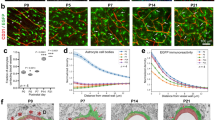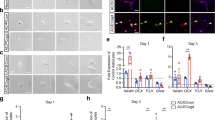Abstract
Astrocytes, the most abundant glial cells of the central nervous system are morphologically complex. They display numerous processes interacting with synapses and blood vessels. At the vascular interface, astrocyte endfeet-terminated processes almost entirely cover the blood vessel surface and participate to the gliovascular unit where important vascular properties of the brain are set such as the blood-brain barrier (BBB) integrity. How specific morphological and functional interactions between astrocytes and the vascular compartment develop has not been fully investigated. Here, we elaborated an original experimental strategy to study the postnatal development of astrocyte perivascular endfeet. Using purified gliovascular units, we focused on the postnatal expression of MLC1 and GlialCAM, two transmembrane proteins forming a complex enriched at the junction between mature astrocyte perivascular endfeet. We showed that MLC1 and GlialCAM were enriched and assembled into mature complexes in astrocyte perivascular endfeet between postnatal days 10 and 15, after the formation of astrocyte perivascular Aquaporin 4 water channels. These events correlated with the increased expression of Claudin-5 and P-gP, two endothelial-specific BBB components. These results illustrate for the first time that astrocyte perivascular endfeet differentiation is a complex and progressive process which correlates with BBB maturation. Moreover, our results suggest that maturation of the astrocyte endfeet MLC1/GlialCAM complex between postnatal days 10 and 15 might be a key event in the gliovascular unit maturation.





Similar content being viewed by others
References
Abbott NJ, Rönnbäck L, Hansson E (2006) Astrocyte–endothelial interactions at the blood–brain barrier. Nat Rev Neurosci 7:41–53. https://doi.org/10.1038/nrn1824
Allen NJ, Eroglu C (2017) Cell biology of astrocyte-synapse interactions. Neuron 96:697–708. https://doi.org/10.1016/j.neuron.2017.09.056
Alvarez JI, Katayama T, Prat A (2013) Glial influence on the blood brain barrier. Glia 61:1939–1958. https://doi.org/10.1002/glia.22575
Amiry-Moghaddam M, Frydenlund DS, Ottersen OP (2004) Anchoring of aquaporin-4 in brain: molecular mechanisms and implications for the physiology and pathophysiology of water transport. Neuroscience 129:999–1010. https://doi.org/10.1016/j.neuroscience.2004.08.049
Armulik A, Genové G, Mäe M et al (2010) Pericytes regulate the blood–brain barrier. Nature 468:557–561. https://doi.org/10.1038/nature09522
Attwell D, Buchan AM, Charpak S et al (2010) Glial and neuronal control of brain blood flow. Nature 468:232–243. https://doi.org/10.1038/nature09613
Ben-Zvi A, Lacoste B, Kur E et al (2014) Mfsd2a is critical for the formation and function of the blood-brain barrier. Nature 509:507–511. https://doi.org/10.1038/nature13324
Boulay A-C, Mazeraud A, Cisternino S et al (2015a) Immune quiescence of the brain is set by astroglial connexin 43. J Neurosci 35:4427–4439. https://doi.org/10.1523/JNEUROSCI.2575-14.2015
Boulay A-C, Saubaméa B, Cisternino S et al (2015b) The Sarcoglycan complex is expressed in the cerebrovascular system and is specifically regulated by astroglial Cx30 channels. Front Cell Neurosci 9:9. https://doi.org/10.3389/fncel.2015.00009
Boulay A-C, Saubaméa B, Declèves X, Cohen-Salmon M (2015c) Purification of mouse brain vessels. J Vis Exper 5:6. https://doi.org/10.3791/53208
Boulay A-C, Saubaméa B, Adam N et al (2017) Translation in astrocyte distal processes sets molecular heterogeneity at the gliovascular interface. Cell Discov 3:17005. https://doi.org/10.1038/celldisc.2017.5
Bugiani M, Dubey M, Breur M et al (2017) Megalencephalic leukoencephalopathy with cysts: the Glialcam-null mouse model. Ann Clin Transl Neurol 4:450–465. https://doi.org/10.1002/acn3.405
Capdevila-Nortes X, López-Hernández T, Apaja PM et al (2013a) Insights into MLC pathogenesis: GlialCAM is an MLC1 chaperone required for proper activation of volume-regulated anion currents. Hum Mol Genet 22:4405–4416. https://doi.org/10.1093/hmg/ddt290
Capdevila-Nortes X, López-Hernández T, Apaja PM et al (2013b) Insights into MLC pathogenesis: GlialCAM is an MLC1 chaperone required for proper activation of volume-regulated anion currents. Hum Mol Genet 22:4405–4416. https://doi.org/10.1093/hmg/ddt290
Chen J, Luo Y, Hui H et al (2017) CD146 coordinates brain endothelial cell–pericyte communication for blood–brain barrier development. PNAS 114:E7622–E7631. https://doi.org/10.1073/pnas.1710848114
Chung Moh M, Hoon Lee L, Shen S (2005) Cloning and characterization of hepaCAM, a novel Ig-like cell adhesion molecule suppressed in human hepatocellular carcinoma. J Hepatol 42:833–841. https://doi.org/10.1016/j.jhep.2005.01.025
Daneman R, Zhou L, Kebede AA, Barres BA (2010) Pericytes are required for blood–brain barrier integrity during embryogenesis. Nature 468:562–566. https://doi.org/10.1038/nature09513
Dubey M, Bugiani M, Ridder MC et al (2015) Mice with megalencephalic leukoencephalopathy with cysts: a developmental angle: MLC in Mouse and Man. Ann Neurol 77:114–131. https://doi.org/10.1002/ana.24307
Ezan P, André P, Cisternino S et al (2012) Deletion of astroglial connexins weakens the blood–brain barrier. J Cereb Blood Flow Metab 32:1457–1467. https://doi.org/10.1038/jcbfm.2012.45
Favre-Kontula L, Rolland A, Bernasconi L et al (2008) GlialCAM, an immunoglobulin-like cell adhesion molecule is expressed in glial cells of the central nervous system. Glia 56:633–645. https://doi.org/10.1002/glia.20640
Ge W-P, Miyawaki A, Gage FH et al (2012) Local generation of glia is a major astrocyte source in postnatal cortex. Nature 484:376–380. https://doi.org/10.1038/nature10959
Hawkes CA, Härtig W, Kacza J et al (2011) Perivascular drainage of solutes is impaired in the ageing mouse brain and in the presence of cerebral amyloid angiopathy. Acta Neuropathol 121:431–443. https://doi.org/10.1007/s00401-011-0801-7
Hoegg-Beiler MB, Sirisi S, Orozco IJ et al (2014) Disrupting MLC1 and GlialCAM and ClC-2 interactions in leukodystrophy entails glial chloride channel dysfunction. Nat Commun 5:3475. https://doi.org/10.1038/ncomms4475
Iliff JJ, Wang M, Liao Y et al (2012) A Paravascular pathway facilitates csf flow through the brain parenchyma and the clearance of interstitial solutes, including amyloid β. Sci Transl Med 4:147ra111–147ra111. https://doi.org/10.1126/scitranslmed.3003748
Iliff JJ, Chen MJ, Plog BA et al (2014) Impairment of glymphatic pathway function promotes tau pathology after traumatic brain injury. J Neurosci 34:16180–16193. https://doi.org/10.1523/JNEUROSCI.3020-14.2014
Jeworutzki E, López-Hernández T, Capdevila-Nortes X et al (2012) GlialCAM, a protein defective in a leukodystrophy, serves as a ClC-2 Cl-channel auxiliary subunit. Neuron 73:951–961. https://doi.org/10.1016/j.neuron.2011.12.039
Jiang X, Nardelli J (2016) Cellular and molecular introduction to brain development. Neurobiol Dis 92:3–17. https://doi.org/10.1016/j.nbd.2015.07.007
López-Hernández T, Ridder MC, Montolio M et al (2011a) Mutant GlialCAM causes megalencephalic leukoencephalopathy with subcortical cysts, benign familial macrocephaly, and macrocephaly with retardation and autism. Am J Hum Genet 88:422–432. https://doi.org/10.1016/j.ajhg.2011.02.009
López-Hernández T, Sirisi S, Capdevila-Nortes X et al (2011b) Molecular mechanisms of MLC1 and GLIALCAM mutations in megalencephalic leukoencephalopathy with subcortical cysts. Hum Mol Genet 20:3266–3277. https://doi.org/10.1093/hmg/ddr238
Lunde LK, Camassa LMA, Hoddevik EH et al (2015) Postnatal development of the molecular complex underlying astrocyte polarization. Brain Struct Funct 220:2087–2101. https://doi.org/10.1007/s00429-014-0775-z
Mathiisen TM, Lehre KP, Danbolt NC, Ottersen OP (2010) The perivascular astroglial sheath provides a complete covering of the brain microvessels: an electron microscopic 3D reconstruction. Glia 58:1094–1103. https://doi.org/10.1002/glia.20990
Mazaré N, Gilbert A, Boulay A-C et al (2018) Connexin 30 is expressed in a subtype of mouse brain pericytes. Brain Struct Funct 223:1017–1024. https://doi.org/10.1007/s00429-017-1562-4
Menezes MJ, McClenahan FK, Leiton CV et al (2014) The extracellular matrix protein laminin α2 regulates the maturation and function of the blood–brain barrier. J Neurosci 34:15260–15280. https://doi.org/10.1523/JNEUROSCI.3678-13.2014
Nagao M, Ogata T, Sawada Y, Gotoh Y (2016) Zbtb20 promotes astrocytogenesis during neocortical development. Nat Commun. https://doi.org/10.1038/ncomms11102
Nitta T, Hata M, Gotoh S et al (2003) Size-selective loosening of the blood-brain barrier in claudin-5-deficient mice. J Cell Biol 161:653–660. https://doi.org/10.1083/jcb.200302070
Obermeier B, Daneman R, Ransohoff RM (2013) Development, maintenance and disruption of the blood–brain barrier. Nat Med 19:1584–1596. https://doi.org/10.1038/nm.3407
Qosa H, Miller DS, Pasinelli P, Trotti D (2015) Regulation of ABC efflux transporters at blood-brain barrier in health and neurological disorders. Brain Res 1628:298–316. https://doi.org/10.1016/j.brainres.2015.07.005
Ridder MC, Boor I, Lodder JC et al (2011) Megalencephalic leucoencephalopathy with cysts: defect in chloride currents and cell volume regulation. Brain 134:3342–3354. https://doi.org/10.1093/brain/awr255
Sakers K, Lake AM, Khazanchi R et al (2017) Astrocytes locally translate transcripts in their peripheral processes. PNAS 114:E3830–E3838. https://doi.org/10.1073/pnas.1617782114
Schinkel AH, Smit JJM, van Tellingen O et al (1994) Disruption of the mouse mdr1a P-glycoprotein gene leads to a deficiency in the blood-brain barrier and to increased sensitivity to drugs. Cell 77:491–502. https://doi.org/10.1016/0092-8674(94)90212-7
Schinkel AH, Wagenaar E, Mol CA, van Deemter L (1996) P-glycoprotein in the blood-brain barrier of mice influences the brain penetration and pharmacological activity of many drugs. J Clin Invest 97:2517–2524. https://doi.org/10.1172/JCI118699
Schmithorst VJ, Vannest J, Lee G et al (2015) Evidence that neurovascular coupling underlying the BOLD effect increases with age during childhood. Hum Brain Mapp 36:1–15. https://doi.org/10.1002/hbm.22608
Schmitt A, Gofferje V, Weber M et al (2003) The brain-specific protein MLC1 implicated in megalencephalic leukoencephalopathy with subcortical cysts is expressed in glial cells in the murine brain. Glia 44:283–295. https://doi.org/10.1002/glia.10304
Sirisi S, Folgueira M, López-Hernández T et al (2014) Megalencephalic leukoencephalopathy with subcortical cysts protein 1 regulates glial surface localization of GLIALCAM from fish to humans. Hum Mol Genet 23:5069–5086. https://doi.org/10.1093/hmg/ddu231
Stogsdill JA, Ramirez J, Liu D et al (2017) Astrocytic neuroligins control astrocyte morphogenesis and synaptogenesis. Nature 551:192–197. https://doi.org/10.1038/nature24638
Sugio S, Tohyama K, Oku S et al (2017) Astrocyte-mediated infantile-onset leukoencephalopathy mouse model. Glia 65:150–168. https://doi.org/10.1002/glia.23084
Tam SJ, Richmond DL, Kaminker JS et al (2012) Death receptors DR6 and TROY regulate brain vascular development. Dev Cell 22:403–417. https://doi.org/10.1016/j.devcel.2011.11.018
Teijido O, Casaroli-Marano R, Kharkovets T et al (2007) Expression patterns of MLC1 protein in the central and peripheral nervous systems. Neurobiol Dis 26:532–545. https://doi.org/10.1016/j.nbd.2007.01.016
van der Knaap MS, Boor I, Estévez R (2012) Megalencephalic leukoencephalopathy with subcortical cysts: chronic white matter oedema due to a defect in brain ion and water homoeostasis. Lancet Neurol 11:973–985. https://doi.org/10.1016/S1474-4422(12)70192-8
Vasile F, Dossi E, Rouach N (2017) Human astrocytes: structure and functions in the healthy brain. Brain Struct Funct 222:2017–2029. https://doi.org/10.1007/s00429-017-1383-5
Wu M, Moh MC, Schwarz H (2016) HepaCAM associates with connexin 43 and enhances its localization in cellular junctions. Sci Rep 6:36218. https://doi.org/10.1038/srep36218
Xie L, Kang H, Xu Q et al (2013) Sleep drives metabolite clearance from the adult brain. Science 342:373–377. https://doi.org/10.1126/science.1241224
Yousif S, Marie-Claire C, Roux F et al (2007) Expression of drug transporters at the blood–brain barrier using an optimized isolated rat brain microvessel strategy. Brain Res 1134:1–11. https://doi.org/10.1016/j.brainres.2006.11.089
Acknowledgments
This work has been financed by FRM “Fondation pour la recherche médicale” (PLP20170939025p60 to AG, AJE20171039094 to MCS and SPF20150934067 to ACB), “Fondation Maladies Rares” to MCS, “Contrat de Plan Etat-Région (CPER) Ile-de-France” to MCS, the European Leukodystrophies Association (ELA) Research Foundation (ELA2012-014C2B to RE), the Spanish Ministerio de Ciencia e Innovación (MICINN) (SAF2015-70377 to RE), the Generalitat de Catalunya (SGR2014-1178 to RE). RE is a recipient of an ICREA Academia prize. We thank Anna Capano for technical help and Philippe Mailly for help in image analysis. We are grateful to Xavier Declèves and Jean-Louis Laplanche for helpful discussions and constant support.
Author information
Authors and Affiliations
Contributions
MC-S and A-CB designed research; AG and A-CB performed research; AG, MC-S and A-CB analyzed data; XEV and RE provided resources; A-CB and MC-S wrote the paper.
Corresponding author
Ethics declarations
Conflict of interest
Authors declare no conflicts of interest.
Additional information
Publisher’s Note
Springer Nature remains neutral with regard to jurisdictional claims in published maps and institutional affiliations.
Electronic supplementary material
Below is the link to the electronic supplementary material.
Rights and permissions
About this article
Cite this article
Gilbert, A., Vidal, X.E., Estevez, R. et al. Postnatal development of the astrocyte perivascular MLC1/GlialCAM complex defines a temporal window for the gliovascular unit maturation. Brain Struct Funct 224, 1267–1278 (2019). https://doi.org/10.1007/s00429-019-01832-w
Received:
Accepted:
Published:
Issue Date:
DOI: https://doi.org/10.1007/s00429-019-01832-w




